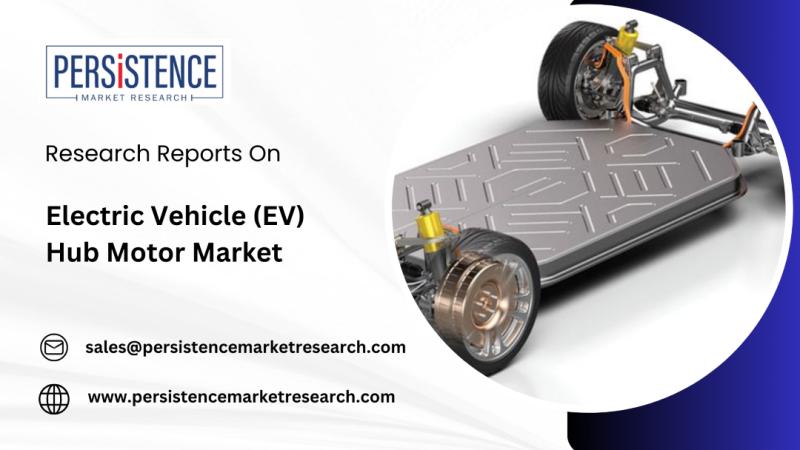Electric Vehicle (EV) Hub Motor Market: A Comprehensive Analysis
The Electric Vehicle (EV) Hub Motor Market is experiencing rapid growth as demand for cleaner, more efficient transportation systems continues to rise globally. With advancements in battery technology, government incentives, and an increasing shift towards sustainable mobility solutions, the market for EV hub motors is projected to expand significantly. This article provides an in-depth look at the current landscape of the electric vehicle hub motor market, key growth drivers, challenges, opportunities, regional insights, and more.
Get a Sample PDF Brochure of the Report (Use Corporate Email ID for a Quick Response): https://www.persistencemarketresearch.com/samples/35006
Overview of the Electric Vehicle Hub Motor Market
The global electric vehicle hub motor market is poised for remarkable growth, with an estimated size of USD 28.9 billion in 2024. This market is expected to rise at a robust compound annual growth rate (CAGR) of 14.1% over the next seven years, reaching a value of USD 72.54 billion by 2031. The adoption of electric vehicles (EVs) is largely driven by the global demand for fuel-efficient, noiseless, and environmentally friendly alternatives to traditional internal combustion engine vehicles. As electric vehicles become more mainstream, the need for high-performance hub motors is intensifying. These motors are integral to enhancing the overall efficiency and performance of EVs, and they represent a crucial component in the ongoing evolution of automotive technologies.
Key growth drivers behind the market expansion include strong government policies, such as subsidies and tax incentives that encourage the adoption of electric vehicles. These initiatives are being particularly emphasized in regions like Europe and North America. Additionally, the global push for reducing carbon emissions is further propelling the transition from conventional vehicles to electric mobility solutions. Technological advancements, such as the integration of AI-powered control systems and enhanced battery technologies, are boosting the performance and appeal of hub motors. Among the various product categories, two-wheelers, particularly in regions like Asia-Pacific, are leading the way in terms of market share. Geographically, North America is expected to hold a significant share of the market, driven by the demand for battery electric vehicles (BEVs).
Key Highlights from the Report
• The global electric vehicle hub motor market is projected to reach USD 72.54 billion by 2031.
• A CAGR of 14.1% is expected in the market from 2024 to 2031.
• Two-wheelers account for 40% of global hub motor usage due to their suitability for short-distance travel.
• The below 1000W power output segment will hold 48% market share in 2024 due to ease of use and cost-effectiveness.
• North America is expected to hold a 35% share of the market by 2024.
• The Asia Pacific region will dominate the market with a 36.5% share, driven by growth in the EV industry.
Market Segmentation
The electric vehicle hub motor market can be segmented based on product type, power output, and end-user category. From a product perspective, hub motors are typically categorized into in-wheel motors and integrated wheel motors. The in-wheel motor type is gaining significant traction as it offers improved efficiency and a reduction in vehicle weight. Additionally, when it comes to power output, the market is divided into three key segments: below 1000W, between 1000W and 3000W, and above 3000W. In 2024, the below 1000W segment is expected to dominate the market, accounting for nearly 48% of the total market share, thanks to its affordability and wide use in smaller vehicles such as electric bikes and scooters.
From an end-user perspective, the market is segmented into passenger cars, commercial vehicles, and two-wheelers. The two-wheeler segment is expected to lead the market, driven by the increasing use of electric bikes and scooters, particularly in urban areas where their compact size and low maintenance costs are highly valued. The passenger car segment is also witnessing robust growth due to rising consumer interest in electric vehicles as eco-friendly transportation alternatives. Meanwhile, the commercial vehicle segment is still in its early stages but holds considerable potential as electric buses and trucks become more common.
Regional Insights
The regional distribution of the electric vehicle hub motor market highlights significant variation in adoption and development rates. North America is expected to hold a substantial share of the market, reaching 35% in 2024. This growth is driven by the increasing demand for battery electric vehicles (BEVs), supported by strong government incentives and a growing infrastructure for EVs. In particular, the United States, with its large number of electric vehicle manufacturers and initiatives to reduce carbon emissions, is a key driver of this market growth.
Asia Pacific, on the other hand, is anticipated to dominate the market with a 36.5% share in 2024. This is due to the rapidly expanding electric vehicle industry in countries such as China, Japan, and India. China, in particular, stands out as the largest EV market globally, with government policies that actively promote electric vehicle production and adoption. The rising demand for electric two-wheelers in Asia Pacific is also contributing to the region’s dominance, with countries like India seeing increasing adoption of electric scooters and bikes.
Market Drivers
The growth of the electric vehicle hub motor market can be largely attributed to a combination of technological, regulatory, and consumer-driven factors. One of the key drivers is the increasing adoption of electric vehicles globally. As governments around the world continue to set ambitious targets for reducing carbon emissions, the demand for EVs is expected to skyrocket. The adoption of electric vehicles is further fueled by incentives such as tax rebates, subsidies, and low-emission zones that encourage consumers to make the switch from internal combustion engine vehicles to electric models.
Technological advancements in electric motors, including the development of more efficient and reliable hub motors, are also playing a critical role in driving market growth. These innovations enhance the performance, efficiency, and overall appeal of electric vehicles. With a focus on reducing vehicle weight, improving energy efficiency, and increasing power density, manufacturers are constantly working on refining hub motor technologies to meet the demands of consumers and regulatory bodies alike.
Market Restraints
Despite the favorable growth prospects, the electric vehicle hub motor market faces certain challenges that could hinder its progress. One of the major restraints is the high initial cost of electric vehicles compared to traditional gasoline-powered vehicles. While the cost of electric vehicle batteries has been declining steadily, the high cost of advanced hub motor systems and other associated technologies remains a barrier for many consumers. This is particularly evident in developing regions where the adoption of EVs is slower due to economic constraints.
Another challenge is the limited charging infrastructure, especially in regions outside of major urban centers. While progress is being made, a lack of widespread and accessible charging stations continues to be a deterrent for many consumers considering electric vehicles. Additionally, the reliance on raw materials such as lithium and cobalt for batteries poses concerns regarding supply chain stability and environmental impact.
Market Opportunities
The electric vehicle hub motor market presents significant opportunities for growth, especially in emerging economies where the demand for affordable and sustainable transportation solutions is on the rise. In regions like Asia-Pacific, the growing middle class and urbanization are expected to drive demand for electric two-wheelers, which offer a cost-effective and environmentally friendly solution to daily commuting.
Moreover, the continuous advancements in battery technology and the increasing investments in charging infrastructure present lucrative opportunities for manufacturers. Innovations such as wireless charging and fast-charging networks are expected to further enhance the convenience and appeal of electric vehicles. Additionally, partnerships between automakers and technology companies to develop AI-powered control systems and other smart technologies will likely lead to the creation of next-generation electric vehicles that are more efficient and user-friendly.
Frequently Asked Questions (FAQs)
How big is the Electric Vehicle Hub Motor Market?
Who are the key players in the global Electric Vehicle Hub Motor Market?
What is the projected growth rate of the Electric Vehicle Hub Motor Market from 2024 to 2031?
What is the market forecast for the Electric Vehicle Hub Motor Market for 2032?
Which region is estimated to dominate the Electric Vehicle Hub Motor Market through the forecast period?
Company Insights
The electric vehicle hub motor market is home to several key players who are at the forefront of driving innovation and market expansion. Leading companies include:
• Protean Electric
• Ziehl-Abegg
• Nidec Corporation
• Bosch
• Schaeffler Group
Recent Developments
1. Nidec Corporation has expanded its EV portfolio by collaborating with international firms, extending its presence in the global electric vehicle market.
2. Protean Electric has introduced advanced in-wheel hub motor technologies to enhance safety, efficiency, and performance in electric vehicles.
Contact Us:
Persistence Market Research
G04 Golden Mile House, Clayponds Lane
Brentford, London, TW8 0GU UK
USA Phone: +1 646-878-6329
UK Phone: +44 203-837-5656
Email: sales@persistencemarketresearch.com
Web: https://www.persistencemarketresearch.com
About Persistence Market Research:
At Persistence Market Research, we specialize in creating research studies that serve as strategic tools for driving business growth. Established as a proprietary firm in 2012, we have evolved into a registered company in England and Wales in 2023 under the name Persistence Research & Consultancy Services Ltd. With a solid foundation, we have completed over 3600 custom and syndicate market research projects, and delivered more than 2700 projects for other leading market research companies’ clients.
Our approach combines traditional market research methods with modern tools to offer comprehensive research solutions. With a decade of experience, we pride ourselves on deriving actionable insights from data to help businesses stay ahead of the competition. Our client base spans multinational corporations, leading consulting firms, investment funds, and government departments. A significant portion of our sales comes from repeat clients, a testament to the value and trust we’ve built over the years.
This release was published on openPR.


